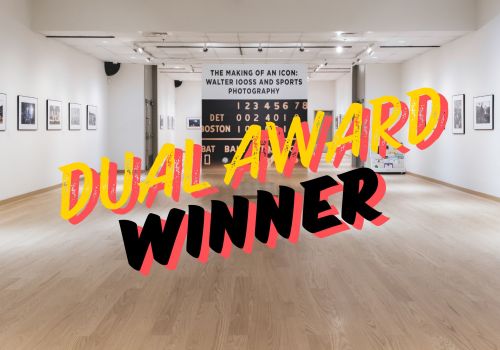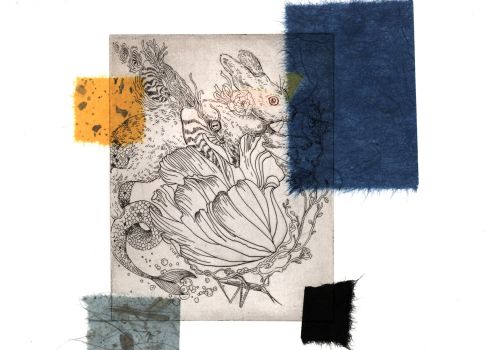
Illustrating Connecticut - Greater New Haven

|
|
|
Murray Tinkelman Cortlandt Manor, New York Paulie and Mexico Reflecting, 1983 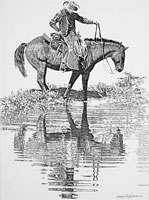 Pen and ink on Bristol board,
22 ½ x 18 ½” Today’s rodeo has evolved from nineteenth-century competitions by cowboys in roundup camps to high-stakes events dominated by professional athletes in large arenas filled with cheering crowds with coverage by ESPN (Bristol, Connecticut). Rodeo’s roots can be traced to the horsemanship and roping traditions of the Spanish conquistadores. These skills, taught to American cowboys by the Spanish padres and vaqueros who dominated the American West before 1848, were valuable as the cattle business began to flourish and as an expanding cowboy population drove cattle to the bustling stockyards of fast-growing towns after the Civil War. The cowboy, however, was soon replaced by the “iron horse” with the completion of the transcontinental railroad in 1869. Out-of-work cowboys sought employment by entertaining spectators at rodeos and extravaganzas such as Buffalo Bill’s Wild West show. ESPN counts the National Finals Rodeo as one of its most popular programs attracting over 13 million viewers. Tinkelman was commissioned by Equus Magazine to do an illustration of a cowboy and his Mustang horse. With a bit of sleuthing, he located Paulie Crotta of Bethany, Connecticut, a rodeo cowboy who specialized in Team Roping events and owned a Mustang named Mexico. The Crotta Ranch is still a hotbed of rodeo team roping and calf roping activity. John Dykes Sudbury, Massachusetts; formerly Fairfield, Connecticut O'Rourke’s Diner, 2001  Acrylic on board,
23 x 29" John Dykes’ illustrations reveal his fascination with offbeat, quirky eateries and doughnut shops located in Connecticut. Of special interest are his depictions of diners in Fairfield and Middlesex counties. O'Rourke’s Diner (Middletown) is one of a series of six paintings created for Yankee Magazine, May 2001 issue, Best New England Diner Pageant. He depicted one diner for each of the six New England states. The concept of diners originated in New England, evolving from lunch wagons that served sandwiches and pies to third shift workers beginning in 1872 in Providence, Rhode Island. These horse drawn wagons eventually became semi-permanent structures with styling based on the railroad's Pullman dining car. With the advent of Art-Deco design, these structures became sleeker and more modern, incorporating Naugahyde vinyl (made in Naugatuck) and metal tubing with gleaming Formica countertops. Initially, these dining wagons would follow workers to their places of employment like today's coffee trucks; over time they became established structures serving the residents of their communities as well as weary travelers looking for a hot, home cooked meal at reasonable prices. Bill Thomson Southington, Connecticut Blue-Blazed Hiking Trails, 2004 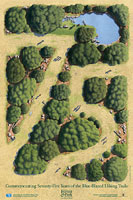 Acrylic with colored pencil,
37 x 28" In 1929, the Connecticut Forest and Park Association Trails Committee under the guidance of Edgar L. Heermance created the Blue-Blazed Hiking Trail System that today extends over 700 miles. The Quinnipiac Trail was the first Blue-Blazed Trail, beginning at Mt. Carmel just above the entrance to Sleeping Giant Park. The original route wound through wooded and paved town roads, along an old Indian trail, and over traprock ridges, including Sleeping Giant, York Mountain, Mad Man's Hill, and Mt. Sanford. Leslie Cober-Gentry Fairfield, Connecticut The First Hamburger Comes from New Haven, Connecticut, 2007  Watercolor, colored pencils, India inks, and collage,
14 x 10 ½" Louis’ Lunch sandwich shop on Crown Street in New Haven, Connecticut, served the first hamburger in the United States in 1895. Founder Louis Lassen sold steak sandwiches at his small lunch wagon and ground the excess beef to form patties served between two pieces of bread. The luncheonette is currently operated by third and fourth generations of the Lassen family who offer their burger specialties on toast with cheese, tomato, and onion, but ketchup or mustard is not provided. Randall Enos Easton, Connecticut Roast Meat Hill, c. 1980 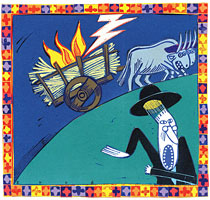 Linocut,
8 x 8" This illustration, featured in Connecticut’s Finest Magazine, depicts one of the accounts of the origin of the name of Roast Meat Hill Road in Killingworth, Connecticut. Thomas L. Lentz, founding member of the Killingworth Historical Society, relates in his book A Photographic History of Killingworth that a hay cart pulled by oxen was struck by lightening, igniting them both. |
|

